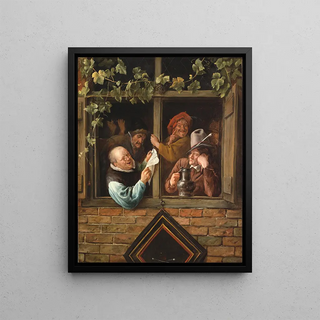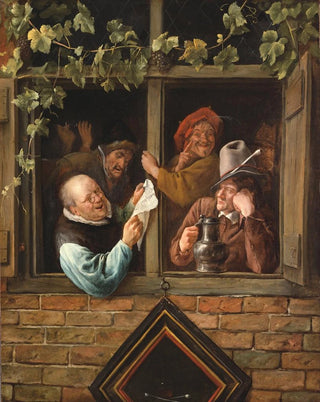Art print | Rhetoricians at the window - Jan Steen


View from behind

Frame (optional)
The artwork "Rhétoriciens à la fenêtre" by Jan Steen is a true invitation to immerse oneself in the vibrant world of 17th-century Dutch painting. This lively scene, where the intimacy of everyday life blends with the depiction of intellectual pursuits, captures the eye and sparks the imagination. Through this composition, Steen offers us a glimpse into the customs of his time, skillfully playing with the conventions of pictorial storytelling. The window, a symbol of openness to the outside world, becomes a frame that reveals exchanges between the characters and their environment, making this piece a painting rich in meaning and emotion.
Style and uniqueness of the artwork
Jan Steen is renowned for his ability to capture life in all its diversity, and "Rhétoriciens à la fenêtre" is no exception. The piece stands out for its dynamism and elaborate composition, where each character appears to be animated by a distinct intention. The facial expressions and gestures of the protagonists convey a range of emotions from curiosity to enthusiasm, making the scene almost alive. The colors, both vivid and harmonious, enhance this sense of movement and interaction. Steen excels in the art of light, creating subtle contrasts that highlight the details of clothing and objects, while infusing a warm atmosphere throughout. This artwork belongs to the genre of genre painting but transcends simple depictions of daily life to offer a reflection on knowledge and communication.
The artist and his influence
Jan Steen, born in Leiden in 1626, is one of the masters of Dutch painting, whose work vividly illustrates themes of domestic life, festivities, and human interactions. His career, marked by prolific output, demonstrates a deep commitment to the social realities of his time. Steen does not merely paint scenes of everyday life; he infuses them with a moral and satirical dimension, inviting viewers to reflect on human behaviors. His influence on subsequent generations of artists is undeniable, with his lively and narrative style inspiring painters such as Pieter

Matte finish

View from behind

Frame (optional)
The artwork "Rhétoriciens à la fenêtre" by Jan Steen is a true invitation to immerse oneself in the vibrant world of 17th-century Dutch painting. This lively scene, where the intimacy of everyday life blends with the depiction of intellectual pursuits, captures the eye and sparks the imagination. Through this composition, Steen offers us a glimpse into the customs of his time, skillfully playing with the conventions of pictorial storytelling. The window, a symbol of openness to the outside world, becomes a frame that reveals exchanges between the characters and their environment, making this piece a painting rich in meaning and emotion.
Style and uniqueness of the artwork
Jan Steen is renowned for his ability to capture life in all its diversity, and "Rhétoriciens à la fenêtre" is no exception. The piece stands out for its dynamism and elaborate composition, where each character appears to be animated by a distinct intention. The facial expressions and gestures of the protagonists convey a range of emotions from curiosity to enthusiasm, making the scene almost alive. The colors, both vivid and harmonious, enhance this sense of movement and interaction. Steen excels in the art of light, creating subtle contrasts that highlight the details of clothing and objects, while infusing a warm atmosphere throughout. This artwork belongs to the genre of genre painting but transcends simple depictions of daily life to offer a reflection on knowledge and communication.
The artist and his influence
Jan Steen, born in Leiden in 1626, is one of the masters of Dutch painting, whose work vividly illustrates themes of domestic life, festivities, and human interactions. His career, marked by prolific output, demonstrates a deep commitment to the social realities of his time. Steen does not merely paint scenes of everyday life; he infuses them with a moral and satirical dimension, inviting viewers to reflect on human behaviors. His influence on subsequent generations of artists is undeniable, with his lively and narrative style inspiring painters such as Pieter






